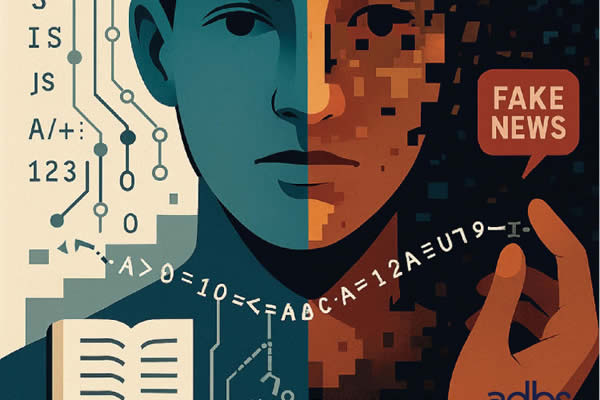What does it mean to be a journalist in an era when AI technology is automating a wide range of tasks once performed exclusively by humans? Rapid advances in AI-driven journalism – from automated news writing and data analysis to real-time content generation – raise pressing questions about the evolving role of human journalists and the division of labour between humans and machines.
Far from being replaced, human journalists have the opportunity to adapt and thrive by strengthening their expertise in critical thinking, investigative analysis, ethical reasoning and contextual storytelling. While AI can efficiently process vast amounts of information and generate reports at unprecedented speed, it lacks the nuanced judgment, deep contextual understanding and moral responsibility required for high-quality journalism. In this changing landscape, the ability to question sources, interpret complex social issues and provide insightful narratives will become even more important.
So instead of competing with AI on tasks that machines are increasingly capable of doing – such as summarising earnings reports or generating basic news updates – journalists need to focus on areas where human intelligence remains irreplaceable. The table below outlines the journalistic roles AI will transform, explaining why certain skills will become less relevant and which technologies can replace them.
| Skill | Why is it becoming obsolete? | What replaces it? |
|---|---|---|
| Manual aggregation and prioritisation of news feeds | AI-driven algorithms can now scan, aggregate and prioritise news feeds in real time, processing vast amounts of information faster than humans. | Automated news aggregation tools and AI-powered content curation systems that filter and rank news based on relevance, engagement and contextual analysis. |
| Editorial selection of website front pages | Front pages are now dynamically personalised based on user preferences through AI-driven algorithms. | AI-powered recommendation systems (A/B testing, dynamic personalisation) |
| Writing news briefs and article summaries | Generative AI can automatically summarise news and extract key points. | AI writing tools and CMS-integrated summary tools |
| Rewriting wire reports | AI can automatically rephrase and adapt newswire content with a specific tone. | AI-driven automation in newsrooms |
| Manual web content layout design | AI-enhanced CMS platforms automate content organisation using optimised dynamic templates. | Smart CMS with AI layout automation |
| Manual moderation of comments and forums | AI filters automatically detect and remove problematic content (e.g., hate speech, spam, misinformation). | AI-powered moderation tools |
| Manual SEO metadata input | AI automates search engine optimisation (SEO) by generating metadata and adapting content strategies. | AI-driven SEO optimisation tools |
| Basic video editing (cuts, subtitles, simple transitions) | AI-driven tools can automatically edit, subtitle, and enhance videos with a single click. | AI-powered video editing software |
| Manual audience analysis (using Google Analytics and other tools) | AI now interprets audience data and provides actionable recommendations. | AI-enhanced analytics tools |
The table below outlines the key skills that will help journalists stand out and demonstrate their unique value in the age of AI.
| Domain | Key theoretical skills (knowledge & understanding) | Practical skills (application in journalism) | Objectives & relevance |
|---|---|---|---|
| Critical thinking & Investigative journalism |
|
|
Encouraging journalism based on investigation, reflection, and in-depth analysis. |
| Ethical journalism & Editorial integrity |
|
|
Maintaining journalistic independence and ethical responsibility in a tech-driven media landscape. |
| AI & journalism |
|
|
Equipping journalists to use AI as an asset while maintaining control over content quality and ethics. |
| Fact-checking & Information disorders |
|
|
Strengthening journalistic credibility by combatting false information effectively. |
| Digital journalism & Multimedia production |
|
|
Enabling journalists to leverage digital tools for news production and distribution. |
| Investigative data journalism |
|
|
Enhancing storytelling with data-driven insights and visual narratives. |
| Source verification & Contextual analysis |
|
|
Distinguishing between credible and unreliable sources for high-quality journalism. |
| Digital security & Protection of sources |
|
|
Ensuring safe journalistic practices in a world of increasing digital surveillance. |
| Audience engagement & Community building |
|
|
Enhancing journalism’s public impact by maintaining strong audience connections. |
| Emerging technologies & Journalism innovation |
|
|
Future-proofing journalism by integrating new storytelling techniques. |
AI literacy appears to have become a transversal skill, referring to the competencies that enable individuals to critically evaluate and effectively use AI technologies. According to the UNESCO, it encompass 17 key competencies.
| Competence | Description / Learning Outcomes |
|---|---|
| 1. Recognising AI | Recognise technological artefacts that use or do not use AI. |
| 2. Understanding Intelligence | Critically analyse and discuss the characteristics that make an entity « intelligent. » Debate the differences between human, animal, and artificial intelligence. |
| 3. Practising Interdisciplinarity | Recognise that there are many ways of thinking about and developing « intelligent » machines. Identify various technologies that use AI, including cognitive systems, robotics, and machine learning. |
| 4. Identifying General vs. Narrow AI | Distinguish between general AI and narrow AI. |
| 5. Strengths and Weaknesses of AI | Identify types of problems where AI excels or does not excel. Determine when AI is relevant and when human skills are necessary. |
| 6. Imagining Future AI | Envision possible future applications of AI and reflect on the effects these applications may have on the world. |
| 7. Representations | Understand what knowledge representation is and describe examples of knowledge representations. |
| 8. Decision-Making | Recognise and describe examples of how computers reason and make decisions. |
| 9. Machine Learning Steps | Understand the steps of machine learning (ML) and the practices and challenges associated with each step. |
| 10. Human Role in AI | Be aware that humans play an important role in programming, selecting models, and developing AI systems. |
| 11. Understanding Data | Understand the basic concepts of data mastery. |
| 12. Learning from Data | Know that computers often learn from data (including their own data). |
| 13. Critical Interpretation of Data | Understand that data requires interpretation. Describe how training examples provided for an initial dataset can affect the results of an algorithm. |
| 14. Action and Reaction | Understand that some AI systems have the ability to physically interact with the world. This action can be driven by reasoning or reactive impulses. |
| 15. Sensors | Understand what sensors are and how computers perceive the world. Identify sensors on a variety of devices. Be aware that different sensors enable different types of representation and reasoning about the world. |
| 16. Ethics | Identify and describe various perspectives on key ethical issues surrounding AI: privacy, employment, misinformation, singularity, decision-making, diversity, bias, transparency, and accountability. |
| 17. Programmability | Understand that agents are programmable. |
These tables serve as a starting point for further reflection and discussion, while providing insights into what journalists need to focus on in their ongoing learning.




